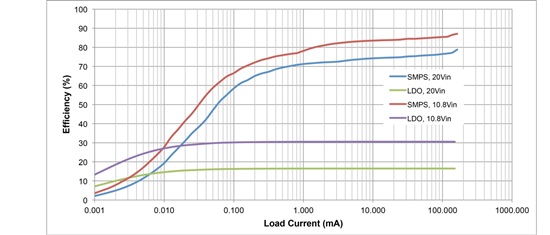If your next product had an efficiency of 30%, would you advertise it as a feature? Or might you contemplate burying this fact deep down in the user’s manual or other documentation? For many simple systems that use tried and true, linear regulators (LDOs) as their power supply, the efficiency may not be much more than 30%. Or it may never be that high at all.
While LDOs are extremely simple, low noise, and very low cost, the main barrier of the LDO is its waste. It doesn’t actually ‘convert’ power from a higher to a lower voltage. Rather, it dissipates power to give you a regulated output voltage. This is simple and low cost, but for many high voltage systems such as those powered by 3-cell lithium batteries and higher voltage AC adaptors it is too inefficient. At heavier loads, the LDO may create significant heat which must be removed from the system. This heat creates a further reliability issue for both the LDO and its adjacent components, if the temperatures become too high due to the higher power dissipation. But for low power, low cost systems that have no thermal concerns, the LDO is still very much a viable and frequently chosen option.
Modern day Switch-mode Power Supplies (SMPSs) are almost as simple as LDOs, but much more efficient. Efficiencies are typically in the 80-90% range for most operating conditions. This results in much less power dissipation, which equates to lower operating temperatures, increased reliability, and longer battery run time.
Finally, even at very low output currents, where LDOs are usually more efficient than a corresponding SMPS, SMPSs have come a long way to closing this gap. Ultra-low power operating modes, such as deep sleep and standby modes, keep the SMPS efficiency at higher levels down to even lower load currents. As I detail here, until the load current decreases to 10 µA, the TPS62177SMPS is still more efficient than a 1-µA Iq LDO. If your system is a smoke alarm with very low current consumption for most of the time, then an LDO may be a better solution considering the low cost of such end equipment, low noise needed for the sensitive sensors, and higher efficiency at the lower power operating point. But if you are powering a notebook, which has higher standby power consumption and much higher peak power consumption, does not need low noise, and is not a lowest cost system, then the SMPS offers advantages.
Which do you prefer, SMPS or LDO? Let me know what you think, after reviewing all the details that I discuss here.



-

Chris Glaser
-
Cancel
-
Up
0
Down
-
-
Reply
-
More
-
Cancel
Comment-

Chris Glaser
-
Cancel
-
Up
0
Down
-
-
Reply
-
More
-
Cancel
Children